An Open-Source Platform for Indoor Environment Monitoring with Participatory Comfort Sensing
Abstract
:1. Introduction
2. Related Work and Contributions
2.1. Related Work
2.2. Motivation and Contribution
3. The PCIEM Platform: Prototype
3.1. The PCFN
Sensor Characterization
3.2. The Base Station
3.3. Database Server
3.4. Automatic Restart on Power Cycle
4. The PCIEM platform: Production Version, Cost, and Deployment
4.1. Production Version of PCFNs
4.2. Cost of the PCIEM Platform
4.3. Deployment in an Office Building
4.4. Data from the PCIEM Platform
5. Lessons Learned
- 1
- Overall, obtaining a functioning prototype of a single PCFN was straightforward. However, obtaining the wireless communication aspect of the PCIEM platform working reliably was much more challenging. Programming the Xbee Pro radios is not trivial. Multiple radios and programming boards tried to eliminate hardware issues. Many radios with lower costs are even easier to use, but we chose Xbee Pro for the simple reason that these radios have been consistently available for many years and are unlikely to disappear in the near future. In the do-it-yourself (DIY) ecosystem of development boards, sensors, and radios, obsolescence is common and frequent. In fact, the company that made one of the radios we tested at the beginning of the project went out of business during the course of the project, making it impossible to buy more radios of that type.
- 2
- As discussed in Section 4.1, the heat generated by the touchscreen was a concern for the temperature sensor. This was resolved by putting the sensor outside the case, but in the future, a more elegant solution will be preferable. In any case, the design of the housing is important to ensure a high degree of airflow into the case, since otherwise the VOC and CO sensors readings will be different from what they are meant to measure: concentrations in the ambient near the PCFN.
- 3
- The current rating of the power supply is important. Because the touchscreen draws considerable power when its display was on, and together with the power draw of the other components, the combined demand can be higher than what a lower-rated 9V power supply can deliver. In such a scenario, the sensors will produce biased readings. This issue was discovered during the prototyping stage when a lower-rated power supply was used.
- 4
- The software for the PCFN was initially written to send the same data packet up to ten times until an acknowledgment (ACK) was received from the receiver at the base station. It was discovered during a network test with many PCFNs that after a few days, the PCFNs stopped sending data. When the “repeat until ACK received feature” was removed from the transmitters, the problem vanished. Although the reason is not quite clear, data transfer was highly reliable even without this feature as reported in Section 4.3, so the feature was removed in the production version.
- 5
- Cyber-security is a potential issue due to the fact that a general-purpose computer (the Raspberry Pi) is part of the base station and is connected to the Internet constantly, while being unattended. These concerns were ameliorated by not keeping a monitor/keyboard/mouse connected to the base station and setting up screen lock and password for the Raspberry Pi.
- 6
- Another lesson learned from the project was the value of ZigBEE mesh networking. A wireless sensor network was developed by our team in a past project for real-time indoor climate control that did not use ZigBEE. The details of the network are described in the two MS theses [26,27]. The network was developed to enable closed-loop HVAC control, and the resulting closed-loop experiments are described in Brooks et al. [25]. Two important lessons were learned in this earlier project; (i) it is important to avoid any proprietary tools in the development, and (ii) ad hoc mesh networking is critical for scalable deployment of a large indoor sensor network. The earlier design used a radio with a proprietary communication protocol (SimpliciTI [28]), which used a star communication topology, meaning that each transmitter had to be in direct range of a receiver. However, indoor spaces are challenging for radio communications, and sometimes two points that are close in Euclidean distance may still be out of range. As a result, range extenders had to be established after an initial deployment indicated the presence of wireless dark spots [27]. The use of mesh networking in this project eliminated that issue and reduced the time needed for deployment tremendously. In fact, the system described here had only one base station in a large building. Yet, it was still able to collect data from all of the PCFNs in the building due to multi-hopping, perhaps aided by the RP-SMA antenna that increased the range. Additionally, with an open protocol with a large user base, many resources are freely available to the developer. That was not the case for the proprietary SimpliciTI protocol, which too made development in the earlier project challenging.
- 7
- Automatic restart of the entire system after a power cycle is critical.
6. Conclusions
Author Contributions
Funding
Institutional Review Board Statement
Informed Consent Statement
Data Availability Statement
Acknowledgments
Conflicts of Interest
Abbreviations
| PCFN | personal comfort feedback node |
| PCIEM | personal comfort and indoor environment measurement |
| HVAC | heating, ventilation, and air conditioning |
References
- Nicol, J.F.; Roaf, S. Rethinking thermal comfort. Build. Res. Information 2017, 45, 711–716. [Google Scholar] [CrossRef]
- American Society of Heating, Refrigeration and Air Conditioning Engineers (ASHRAE). In The ASHRAE Handbook Fundamentals (SI Edition); ASHRAE: Atlanta, GA, USA, 2009.
- Fanger, P.O. Thermal Comfort; McGraw-Hill Book Company: New York, NY, USA, 1972. [Google Scholar]
- Erickson, V.L.; Cerpa, A.E. Thermovote: Participatory Sensing for Efficient Building HVAC Conditioning. In Proceedings of the 4th ACM Workshop on Embedded Sensing Systems for Energy-Efficiency in Buildings, Toronto, ON, Canada, 6 November 2012; Association for Computing Machinery: New York, NY, USA, 2012; pp. 9–16. [Google Scholar] [CrossRef]
- Jazizadeh, F.; Ghahramani, A.; Becerik-Gerber, B.; Kichkaylo, T.; Orosz, M. User-led decentralized thermal comfort driven HVAC operations for improved efficiency in office buildings. Energy Build. 2014, 70, 398–410. [Google Scholar] [CrossRef]
- Barooah, P. PCIEM-Net: (read as p-c-m net) a system for Personal Comfort and Indoor Environment Monitoring, with a Participatory-Sensing-Enabled Wireless Network and Database Management Module. 2022. Available online: https://gitlab.com/pbarooah/pcmnet (accessed on 5 December 2022).
- Kim, J.Y.; Chu, C.H.; Shin, S.M. ISSAQ: An Integrated Sensing Systems for Real-Time Indoor Air Quality Monitoring. IEEE Sensors J. 2014, 14, 4230–4244. [Google Scholar] [CrossRef]
- Ali, A.S.; Zanzinger, Z.; Debose, D.; Stephens, B. Open Source Building Science Sensors (OSBSS): A low-cost Arduino-based platform for long-term indoor environmental data collection. Build. Environ. 2016, 100, 114–126. [Google Scholar] [CrossRef] [Green Version]
- Karami, M.; McMorrow, G.V.; Wang, L. Continuous monitoring of indoor environmental quality using an Arduino-based data acquisition system. J. Build. Eng. 2018, 19, 412–419. [Google Scholar] [CrossRef]
- Chojer, H.; Branco, P.; Martins, F.; Alvim-Ferraz, M.; Sousa, S. Development of low-cost indoor air quality monitoring devices: Recent advancements. Sci. Total. Environ. 2020, 727, 138385. [Google Scholar] [CrossRef] [PubMed]
- Fritz, H.; Bastami, S.; Lin, C.; Nweye, K.; To, T.; Chen, L.; Le, D.; Ibarra, A.; Zhang, W.; Park, J.Y.; et al. Design, fabrication, and calibration of the Building EnVironment and Occupancy (BEVO) Beacon: A rapidly-deployable and affordable indoor environmental quality monitor. Build. Environ. 2022, 222, 109432. [Google Scholar] [CrossRef]
- Nkurikiyeyezu, K.; Suzuki, Y.; Tobe, Y.; Lopez, G.; Itao, K. Heart rate variability as an indicator of thermal comfort state. In Proceedings of the 56th Annual Conference of Japan Society of Instrumentation Control Engineers, Kanazawa, Japan, 19–22 September 2017; pp. 1510–1512. [Google Scholar] [CrossRef] [Green Version]
- Dai, C.; Zhang, H.; Arens, E.; Lian, Z. Machine learning approaches to predict thermal demands using skin temperatures: Steady-state conditions. Build. Environ. 2017, 114, 1–10. [Google Scholar] [CrossRef]
- Liu, S.; Schiavon, S.; Das, H.P.; Jin, M.; Spanos, C.J. Personal thermal comfort models with wearable sensors. Build. Environ. 2019, 162, 106281. [Google Scholar] [CrossRef] [Green Version]
- Quintana, M.; Abdelrahman, M.; Frei, M.; Tartarini, F.; Miller, C. Longitudinal Personal Thermal Comfort Preference Data in the Wild. In Proceedings of the 19th ACM Conference on Embedded Networked Sensor Systems, Coimbra, Portugal, 15–17 November 2021; pp. 556–559. [Google Scholar]
- Gupta, S.K.; Atkinson, S.; O’Boyle, I.; Drogo, J.; Kar, K.; Mishra, S.; Wen, J.T. BEES: Real-time occupant feedback and environmental learning framework for collaborative thermal management in multi-zone, multi-occupant buildings. Energy Build. 2016, 125, 142–152. [Google Scholar] [CrossRef]
- Abdelrahman, M.M.; Miller, C. Targeting occupant feedback using digital twins: Adaptive spatial–temporal thermal preference sampling to optimize personal comfort models. Build. Environ. 2022, 218, 109090. [Google Scholar] [CrossRef]
- Li, D.; Menassa, C.C.; Kamat, V.R. Robust non-intrusive interpretation of occupant thermal comfort in built environments with low-cost networked thermal cameras. Appl. Energy 2019, 251, 113336. [Google Scholar] [CrossRef]
- Aryal, A.; Becerik-Gerber, B. A comparative study of predicting individual thermal sensation and satisfaction using wrist-worn temperature sensor, thermal camera and ambient temperature sensor. Build. Environ. 2019, 160, 106223. [Google Scholar] [CrossRef]
- Pitt, L.; Green, P.R.; Lennox, B. A sensor network for predicting and maintaining occupant comfort. In Proceedings of the 2013 IEEE Workshop on Environmental Energy and Structural Monitoring Systems, Trento, Italy, 11–12 September 2013; pp. 1–6. [Google Scholar] [CrossRef]
- Feldmeier, M.; Paradiso, J.A. Personalized HVAC control system. In Proceedings of the In Internet of Things 2010 Conference, Tokyo, Japan, 29 November–1 December 2010; p. 8. [Google Scholar]
- Jung, S.; Jeoung, J.; Hong, T. Occupant-centered real-time control of indoor temperature using deep learning algorithms. Build. Environ. 2022, 208, 108633. [Google Scholar] [CrossRef]
- Li, D.; Menassa, C.C.; Kamat, V.R.; Byon, E. HEAT-Human Embodied Autonomous Thermostat. Build. Environ. 2020, 178, 106879. [Google Scholar] [CrossRef]
- Lee, J.; Su, Y.; Shen, C. A Comparative Study of Wireless Protocols: Bluetooth, UWB, ZigBee, and Wi-Fi. In Proceedings of the IECON 2007-33rd Annual Conference of the IEEE Industrial Electronics Society, Taipei, Taiwan, 5–8 November 2007; pp. 46–51. [Google Scholar] [CrossRef] [Green Version]
- Brooks, J.; Goyal, S.; Subramany, R.; Lin, Y.; Liao, C.; Middelkoop, T.; Ingley, H.; Arpan, L.; Barooah, P. Experimental evaluation of occupancy-based energy-efficient climate control of VAV terminal units. Sci. Technol. Built Environ. 2015, 21, 469–480. [Google Scholar] [CrossRef]
- Subramany, R. Wireless Sensor Network for HVAC Control. Master’s Thesis, University of Florida, Gainesville, FL, USA, 2013. [Google Scholar]
- Kumar, S. Improved Wireless Sensor Network for HVAC Control. Master’s Thesis, University of Florida, Gainesville, FL, USA, 2014. [Google Scholar]
- Texas Instruments (TI). Wireless Sensor Network Using eZ430-RF2500; TI: Dallas, TX, USA, 2011. [Google Scholar]


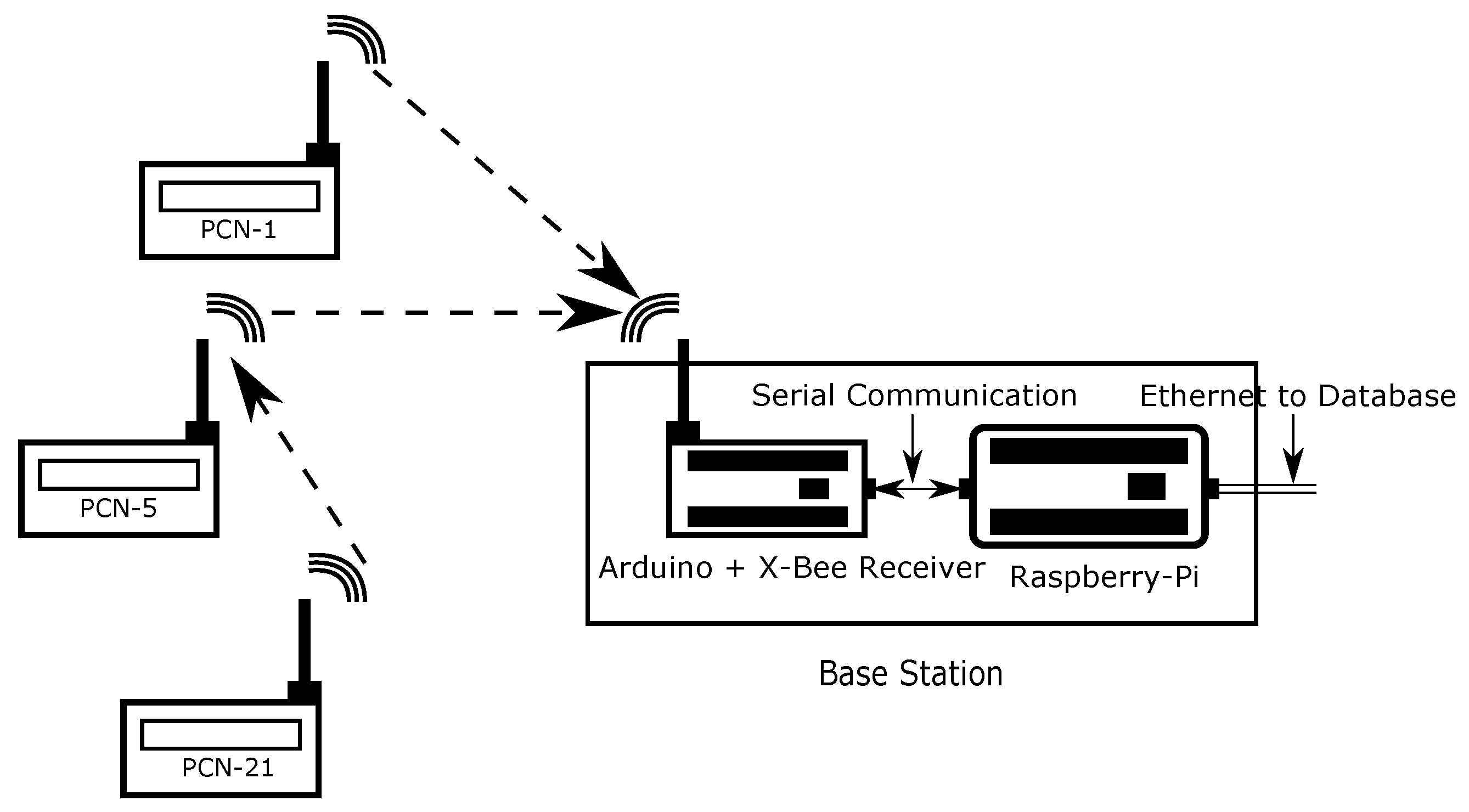

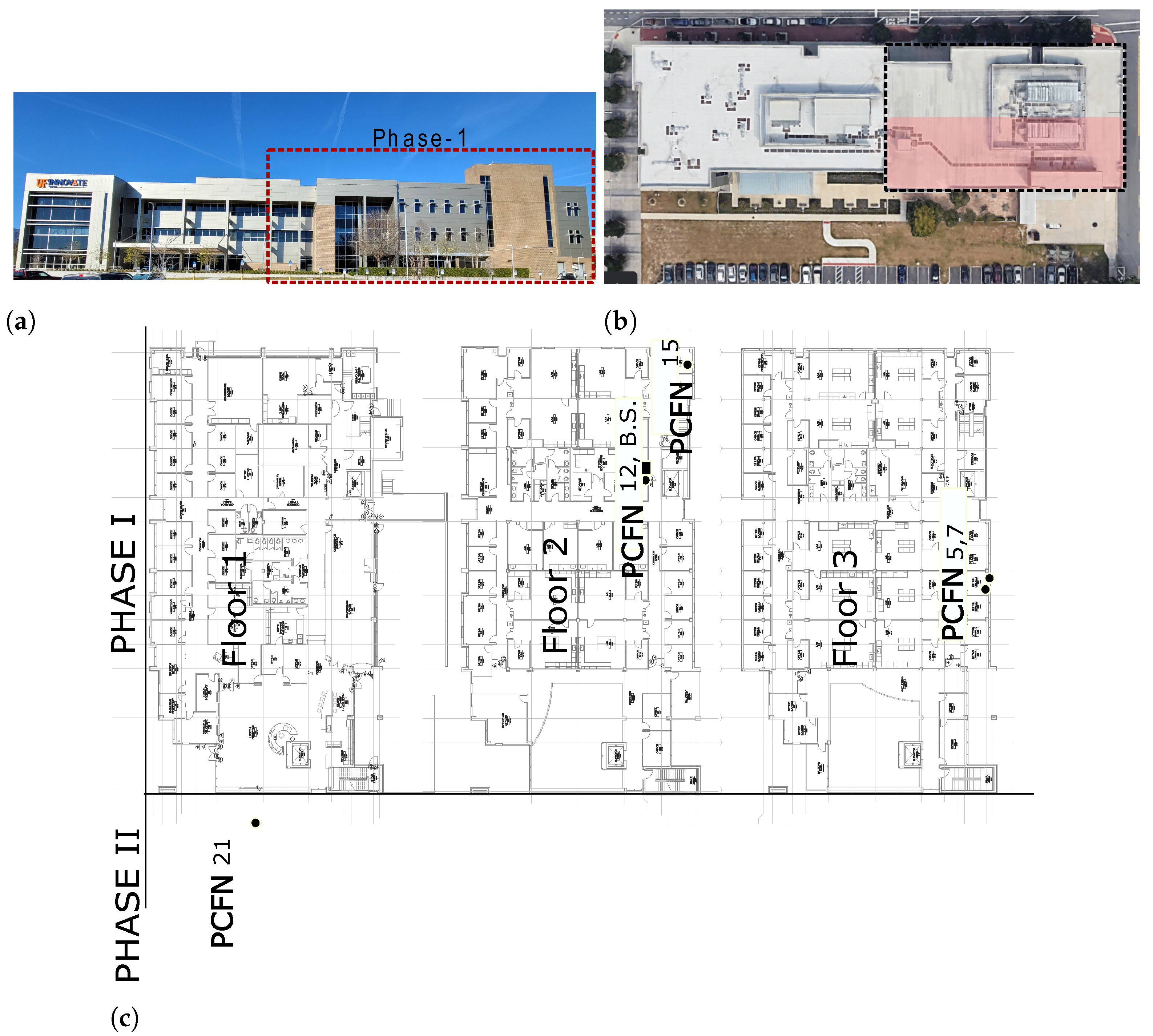
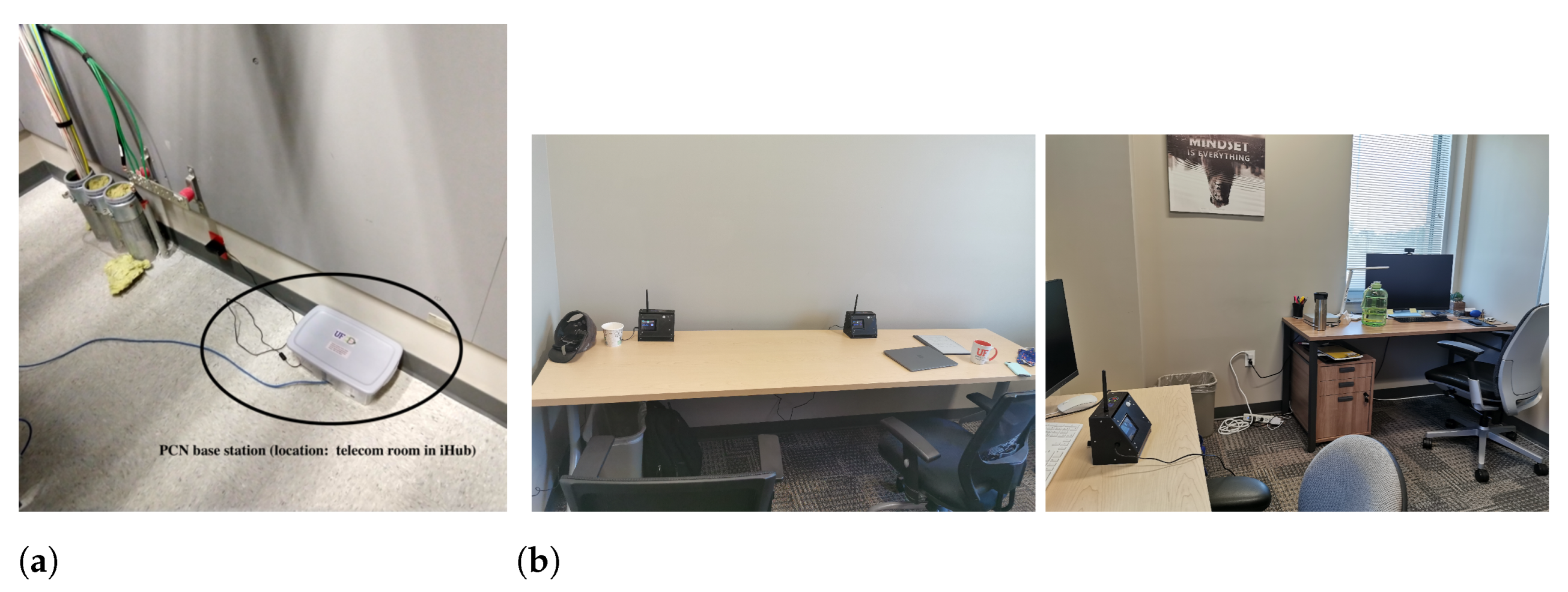
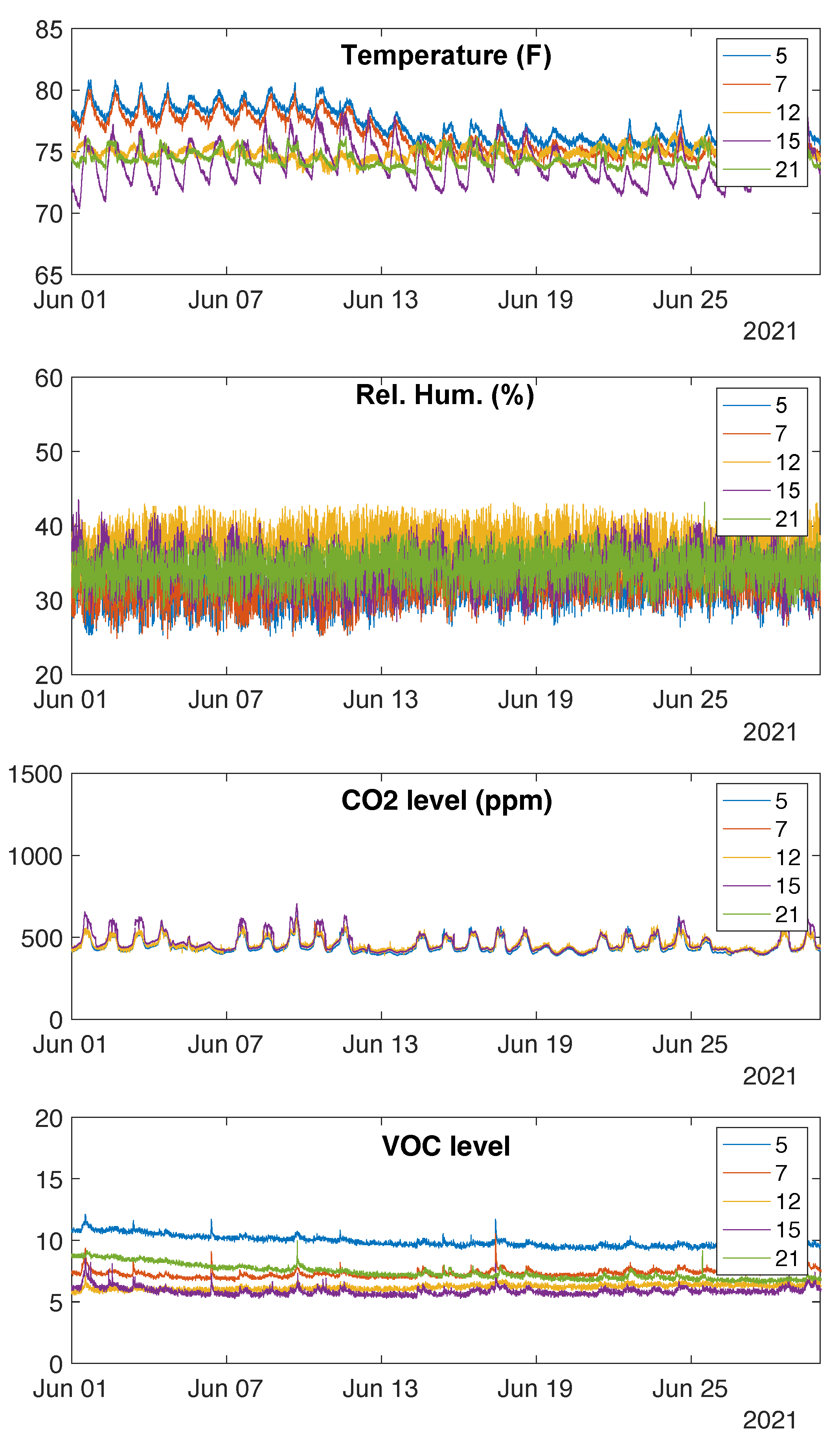
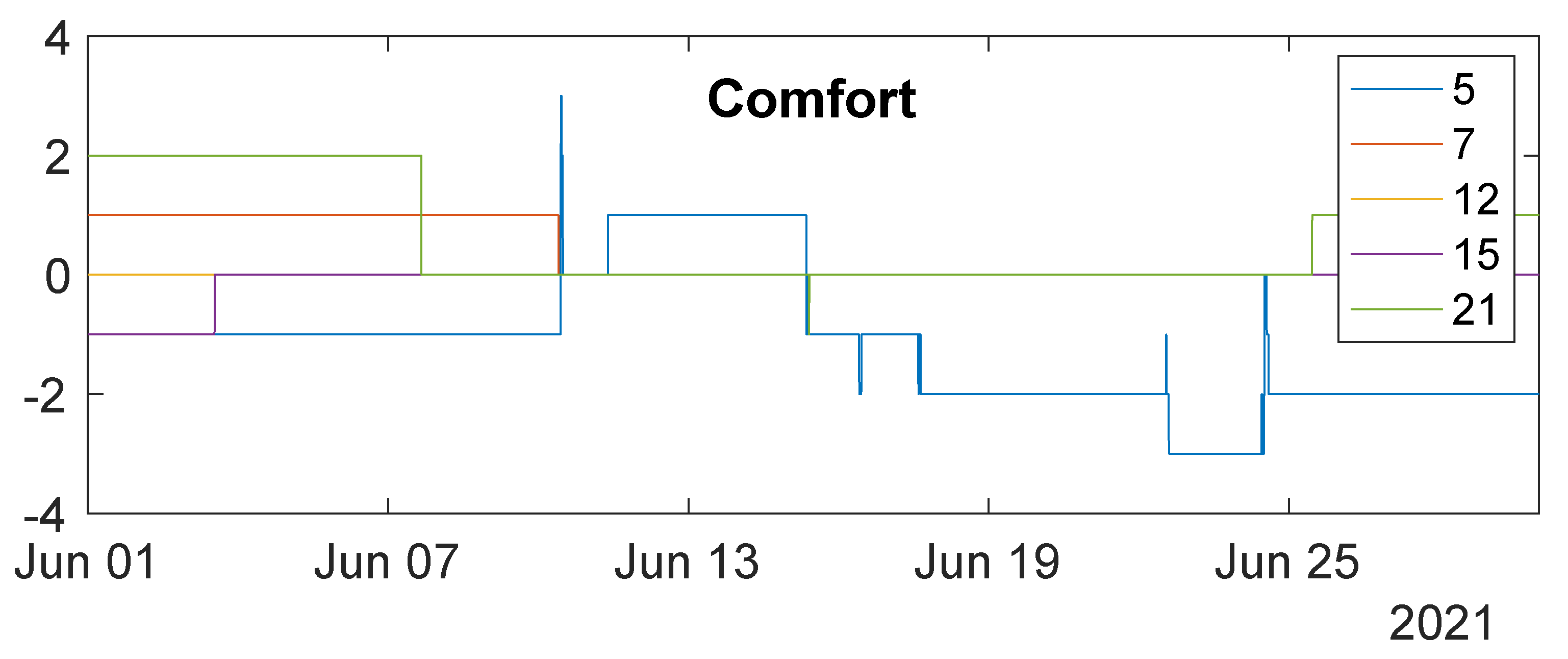
| Parts | Description | |
|---|---|---|
| Sensors | Part Name/Description | Pricein $ |
| VOC Sensor | MICS-5524 | 11.96 |
| CO Sensor | K-30 | 85 |
| Motion detector | Parallax PIR | 4.86 |
| Light Sensor | DigiKey PDV-P8103 | 0.65 |
| Humidity Sensor | HIH-4030-003 | 5.9 |
| Temperature Sensor | DS18B20+ | 3.98 |
| Hardware | ||
| Capacitive Touch Screen | Adafruit 2.8” TFT | 40.46 |
| Microprocessor | ATMEGA2560-16AU | 14.28 |
| XBEE-Pro Radio 2.4 GHz | XBP24CZ7SIT-004 | 32.56 |
| Duck Antenna | A24-HASM-450 | 5.5 |
| Voltage Supply | DigiKey L6R12H-090 | 6.3 |
| PCBs | – | 15 |
| Miscellaneous | screws, jumpers, housing | 20 |
| Assembly cost | - | 100 |
| Total | 331.4 | |
Disclaimer/Publisher’s Note: The statements, opinions and data contained in all publications are solely those of the individual author(s) and contributor(s) and not of MDPI and/or the editor(s). MDPI and/or the editor(s) disclaim responsibility for any injury to people or property resulting from any ideas, methods, instructions or products referred to in the content. |
© 2022 by the authors. Licensee MDPI, Basel, Switzerland. This article is an open access article distributed under the terms and conditions of the Creative Commons Attribution (CC BY) license (https://creativecommons.org/licenses/by/4.0/).
Share and Cite
Rosenberger, J.; Guo, Z.; Coffman, A.; Agdas, D.; Barooah, P. An Open-Source Platform for Indoor Environment Monitoring with Participatory Comfort Sensing. Sensors 2023, 23, 364. https://doi.org/10.3390/s23010364
Rosenberger J, Guo Z, Coffman A, Agdas D, Barooah P. An Open-Source Platform for Indoor Environment Monitoring with Participatory Comfort Sensing. Sensors. 2023; 23(1):364. https://doi.org/10.3390/s23010364
Chicago/Turabian StyleRosenberger, Joseph, Zhong Guo, Austin Coffman, Duzgun Agdas, and Prabir Barooah. 2023. "An Open-Source Platform for Indoor Environment Monitoring with Participatory Comfort Sensing" Sensors 23, no. 1: 364. https://doi.org/10.3390/s23010364
APA StyleRosenberger, J., Guo, Z., Coffman, A., Agdas, D., & Barooah, P. (2023). An Open-Source Platform for Indoor Environment Monitoring with Participatory Comfort Sensing. Sensors, 23(1), 364. https://doi.org/10.3390/s23010364






